The Intel 6th Gen Skylake Review: Core i7-6700K and i5-6600K Tested
by Ian Cutress on August 5, 2015 8:00 AM ESTGenerational Tests on the i7-6700K: Legacy, Office and Web Benchmarks
Moving on to the generational tests, and similar to our last Broadwell review I want to dedicate a few pages to specifically looking at how stock speed processors perform as Intel has released each generation. For this each CPU is left at stock, DRAM set to DDR3-1600 (or DDR4-2133 for Skylake in DDR4 mode) and we run the full line of CPU tests at our disposal.
Legacy
Some users will notice that in our benchmark database Bench, we keep data on the CPUs we’ve tested back over a decade and the benchmarks we were running back then. For a few of these benchmarks, such as Cinebench R10, we do actually run these on the new CPUs as well, although for the sake of brevity and relevance we tend not to put this data in the review. Well here are a few of those numbers too.

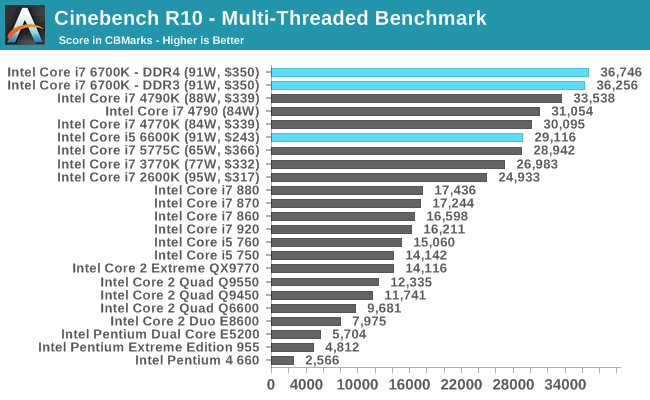


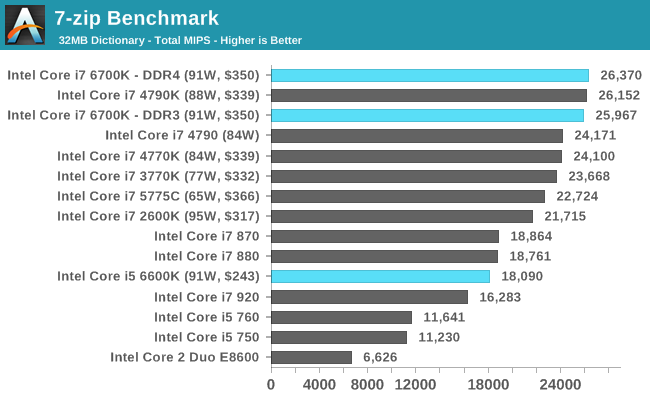
Even with the older tests that might not include any new instruction sets, the Skylake CPUs sit on top of the stack.
Office Performance
The dynamics of CPU Turbo modes, both Intel and AMD, can cause concern during environments with a variable threaded workload. There is also an added issue of the motherboard remaining consistent, depending on how the motherboard manufacturer wants to add in their own boosting technologies over the ones that Intel would prefer they used. In order to remain consistent, we implement an OS-level unique high performance mode on all the CPUs we test which should override any motherboard manufacturer performance mode.
Dolphin Benchmark: link
Many emulators are often bound by single thread CPU performance, and general reports tended to suggest that Haswell provided a significant boost to emulator performance. This benchmark runs a Wii program that raytraces a complex 3D scene inside the Dolphin Wii emulator. Performance on this benchmark is a good proxy of the speed of Dolphin CPU emulation, which is an intensive single core task using most aspects of a CPU. Results are given in minutes, where the Wii itself scores 17.53 minutes.
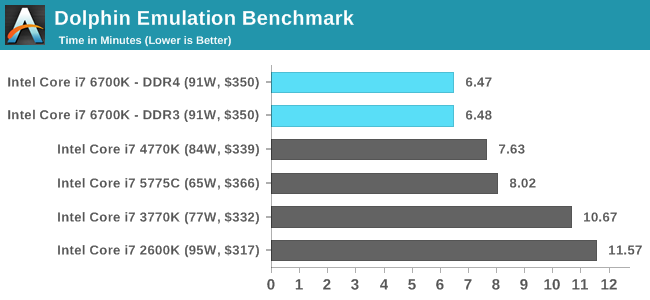
WinRAR 5.0.1: link
Our WinRAR test from 2013 is updated to the latest version of WinRAR at the start of 2014. We compress a set of 2867 files across 320 folders totalling 1.52 GB in size – 95% of these files are small typical website files, and the rest (90% of the size) are small 30 second 720p videos.

3D Particle Movement
3DPM is a self-penned benchmark, taking basic 3D movement algorithms used in Brownian Motion simulations and testing them for speed. High floating point performance, MHz and IPC wins in the single thread version, whereas the multithread version has to handle the threads and loves more cores.
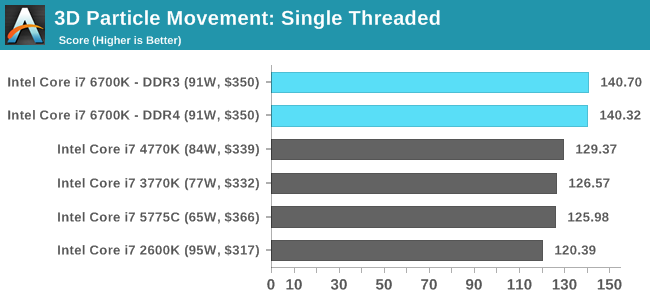
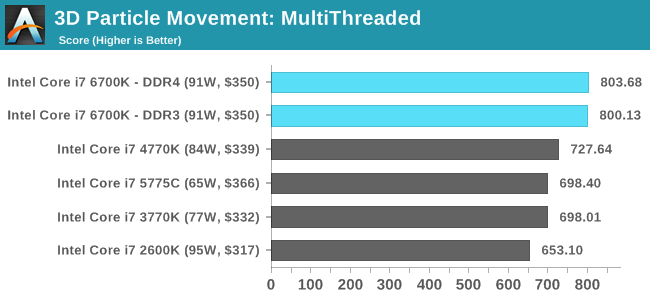
FastStone Image Viewer 4.9
FastStone is the program I use to perform quick or bulk actions on images, such as resizing, adjusting for color and cropping. In our test we take a series of 170 images in various sizes and formats and convert them all into 640x480 .gif files, maintaining the aspect ratio. FastStone does not use multithreading for this test, and results are given in seconds.
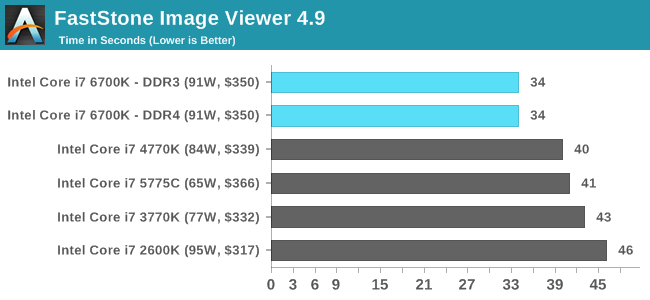
Web Benchmarks
On the lower end processors, general usability is a big factor of experience, especially as we move into the HTML5 era of web browsing. For our web benchmarks, we take four well known tests with Chrome 35 as a consistent browser.
Sunspider 1.0.2
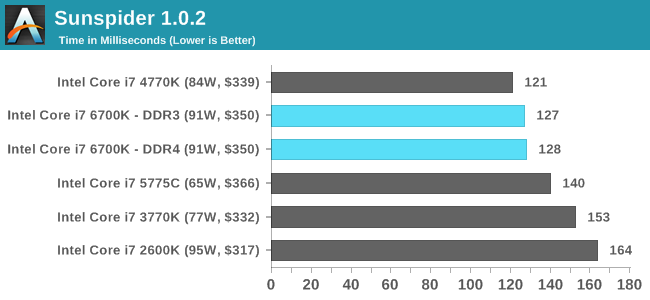
Mozilla Kraken 1.1
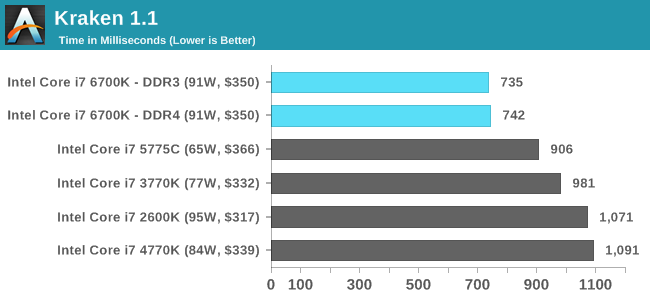
WebXPRT
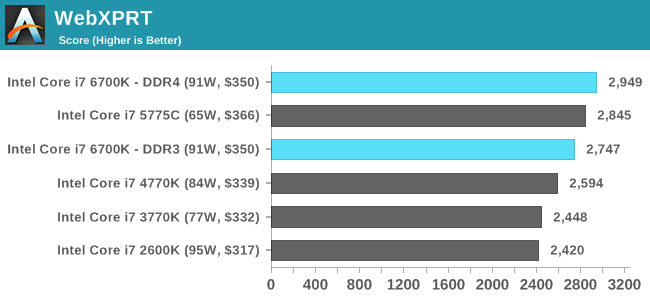
Google Octane v2
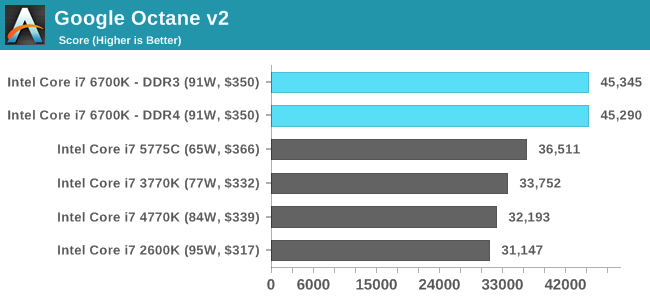










477 Comments
View All Comments
nsteussy - Tuesday, August 11, 2015 - link
Ian, under the Linux benchmarks you have the graphic for the NAMD Mol Dynamics twice but none for the NPB fluid dynamics. That said, that is quite the nice bump for NAMD (~24% from a 4770 to a 6770). Very tempting.Visual - Wednesday, August 12, 2015 - link
I kinda don't like how you keep repeating the generic benchmark descriptions before each graph. I'd prefer if it were hidden by default, visible on hover or toggled by clicking of some info button or similar, or at the very least formatted a bit different than actual article text.I'd also like if you had some comments on the actual results, at least where there are some peculiarities in them.
Case in point: Why is the 5775C IGP so much better in some games?
mapesdhs - Wednesday, August 12, 2015 - link
Agree re comments on results, eg. why does the 2600K dip so badly for Shadow of Mordor @ 4K with the GTX 770? It doesn't happen with the 980, but if the dip was a VRAM issue @ 4K then the 3770K shouldn't be so close to the other CPUs. Weird...wyssin - Wednesday, August 12, 2015 - link
Has anyone published a review comparing i7-6700k with other cpus all overclocked to, say, 4.5 GHz? For those who typically run an overclocked system, it's not an apples-to-apples comparison to put the new entry up against the older all at stock settings.So to make the best-informed decision, it would be very useful to be able to see head-to-head trials at both (1) stock settings and (2) overclocked to a speed they can all reasonably manage (apparently around 4.4 or 4.5 GHz).
I have the same problems with the Guru3D review and the Gamestar.de review that were mentioned in earlier comments.
Oxford Guy - Thursday, August 13, 2015 - link
The key is to pick a speed that the worst overclocking examples would be able to get to with reasonable voltage. That takes the luck of the draw out of the scenario.beatsbyden - Thursday, August 13, 2015 - link
Not much improvent. Only worth the money if you're coming from an I5Darkvengence - Thursday, August 13, 2015 - link
This lack of CPU power needed in gaming is only temporary once u have photorealistic graphics in 4k u gonna need crazy powerful GPUs which need feeding by beastly CPUs . our current technology will seem like a dinosaur CPU in comparison. That is of course a fair few years away but still one day it will happen . I'm glad current CPU are not being taxed by today's games even less with dx12. Gives my gen 1 MSI nightblade more life with 4970k as u can't change motherboard it all custom front panel connectors and stuff. I used to have a i7 920 and got to say that is still a good CPU especially for single GPU systems. I really like sandy bridge tho very impressive for its age. But older CPUs lose out mainly being tied to older chipsets so u lose new connector and bus speeds for hardware thogasparmx - Thursday, November 19, 2015 - link
I think you're kinda wrong, the point of DX12 is depending less on CPU, NVIDIA says in the future probably you're not going to need a beast CPU to play 4k games.djscrew - Friday, August 14, 2015 - link
I'm so disappointed in SB/DDR4. After all this wait and the IPC gains with discreet graphics are negative? WTF Intel. I Guess my Nehalem system will survive another generation, or maybe three? No compelling reason to upgrade. It's such a shame because I was really looking forward to building a $3k rig. I think I'll shop for a nice 4k panel instead.Ninjawithagun - Friday, August 14, 2015 - link
And just when I was about to purchase the 6600K and a Z170 mini-ITX motherboard as an upgrade to my 4690K and Z97i Plus motherboard...man, am I glad I ran across this article. Saved myself about $600 for a useless upgrade!